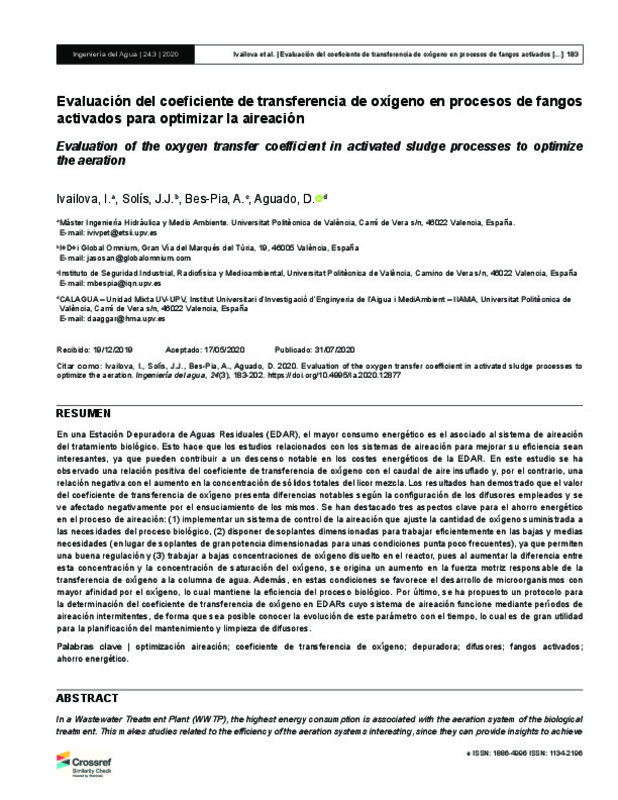Al Ba'ba'a, H.B., Amano, R.S. 2017. A study of optimum aeration efficiency of a lab-scale air-diffused system. Water and Environment Journal, 31(3), 432-439. https://doi.org/10.1111/wej.12261
Albaladejo-Ruiz, A., Albaladejo-Falcó, A. 2016. Parametrización del consumo energético de las depuradoras de aguas residuales (levante español). Dyna (Spain), 91(1), 82-87. https://doi.org/10.6036/7527
APHA, AWWA, WEF. 2012. American Public Health Association, American Water Works Association, Water Environment Federation, Standard Methods for the Examination of Water and Wastewater. 22nd ed., Am. Public Heal. Assoc. Washington, DC, USA. ISBN 9780875532356
[+]
Al Ba'ba'a, H.B., Amano, R.S. 2017. A study of optimum aeration efficiency of a lab-scale air-diffused system. Water and Environment Journal, 31(3), 432-439. https://doi.org/10.1111/wej.12261
Albaladejo-Ruiz, A., Albaladejo-Falcó, A. 2016. Parametrización del consumo energético de las depuradoras de aguas residuales (levante español). Dyna (Spain), 91(1), 82-87. https://doi.org/10.6036/7527
APHA, AWWA, WEF. 2012. American Public Health Association, American Water Works Association, Water Environment Federation, Standard Methods for the Examination of Water and Wastewater. 22nd ed., Am. Public Heal. Assoc. Washington, DC, USA. ISBN 9780875532356
Baylar, A., Ozkan, F. 2006. Applications of venturi principle to water aeration systems. Environmental Fluid Mechanics, 6(4), 341-357. https://doi.org/10.1007/s10652-005-5664-9
Bolles, S. 2006. Modeling wastewater aeration systems to discover energy savings opportunities. Process Energy Services LLC.
Boog, J., Nivala, J., Kalbacher, T., van Afferden, M., Müller, R.A. 2020. Do wastewater pollutants impact oxygen transfer in aerated horizontal flow wetlands? Chemical Engineering Journal, 383, 123173. https://doi.org/10.1016/j.cej.2019.123173
Boyle, W., Craven, A., Danely, W., Riech, M. 1996. Oxygen transfer study at the Madison metropolitan sewerage district facilities. Risk Reduction Engineering Laboratory, Office of research and Division, US EPA, Cincinnati.
Chern, J.M., Yang, S. 2003. Oxygen transfer rate in a coarse bubble diffused aeration systems. Industrial & Engineering Chemistry Research, 42(25), 6653-6660. https://doi.org/10.1021/ie030396y
Collivignarelli, M.C., Abbà, A., Bertanza, G. 2019. Oxygen transfer improvement in MBBR process. Environmental Science and Pollution Research, 26(11), 10727-10737. https://doi.org/10.1007/s11356-019-04535-1
Fan, H., Qi, L., Liu, G., Zhang, Y., Fan, Q., Wang, H. 2017. Science Direct Aeration optimization through operation at low dissolved oxygen concentrations: Evaluation of oxygen mass transfer dynamics in different activated sludge systems. Journal of environmental sciences, 55(2017), 224-235. https://doi.org/10.1016/j.jes.2016.08.008
Ferrer, J., Aguado, D., Barat, R., Serralta, J., Lapuente, E. 2017. Huella energética en el ciclo integral del agua en la Comunidad de Madrid. Fundación Canal Isabel II. ISBN: 978-84-945176-8-6
Ferrer Polo, J. 2007. Tratamientos biológicos de aguas residuales (2a ed..; A. Seco Torrecillas, ed.). Valencia: Editorial UPV, D.L. 2007, 2012.
Foladori, P., Vaccari, M., Vitali, F. 2015. Energy audit in small wastewater treatment plants: methodology, energy consumption indicators, and lessons learned. https://doi.org/10.2166/wst.2015.306
García-Ochoa, F., Gómez, E. 2009. Bioreactor scale-up and oxygen transfer rate in microbial processes: An overview. Biotechnology Advances, 27(2), 153-176. https://doi.org/10.1016/j.biotechadv.2008.10.006
Germain, E., Stephenson, T. 2005. Biomass characteristics, aeration and oxygen transfer in membrane bioreactors: their interrelations explained by a review of aerobic biological processes. Reviews in Environmental Science and Bio/Technology, 4(4), 223. https://doi.org/10.1007/s11157-005-2097-3
Germain, E., Nelles, F., Drews, A., Pearce, P., Kraume, M., Reid, E., Stephenson, T. 2007. Biomass effects on oxygen transfer in membrane bioreactors. Water Research, 41(5), 1038-1044. https://doi.org/10.1016/j.watres.2006.10.020
Henkel, J. 2012. Oxygen Transfer Phenomena in Activated Sludge. Retrieved from http://tuprints.ulb.tu-darmstadt.de/3008/1/Henkel-2010-Oxygen_Transfer_Phenomena_in_Activated_Sludge.pdf
Jenkins, T.E. 2014. Aeration control system design: a practical guide to energy and process optimization (First edit). Hoboken, New Jersey: Wiley. https://doi.org/10.1002/9781118777732
Jiang, L.M., Chen, L., Zhou, Z., Sun, D., Li, Y., Zhang, M., Yao, J. 2020. Fouling characterization and aeration performance recovery of fine-pore diffusers operated for 10 years in a full-scale wastewater treatment plant. Bioresource Technology, 307, 123197. https://doi.org/10.1016/j.biortech.2020.123197
Khatri, N., Khatri, K.K., Sharma, A. 2020. Enhanced Energy Saving in Wastewater Treatment Plant using Dissolved Oxygen Control and Hydrocyclone. Environmental Technology & Innovation, 18, 100678. https://doi.org/10.1016/j.eti.2020.100678
Leu, S.Y., Rosso, D., Larson, L.E., Stenstrom, M.K. 2009. Real-Time Aeration Efficiency Monitoring in the Activated Sludge Process and Methods to Reduce Energy Consumption and Operating Costs. Water Environment Research, 81(12), 2471-2481. https://doi.org/10.2175/106143009X425906
Lindberg, C.F. 1997. Control and estimation strategies applied to the activated sludge process. Finland: Uppsala University.
Liu G., Wang J., Campbell K. 2018. Formation of filamentous microorganisms impedes oxygen transfer and decreases aeration efficiency for wastewater treatment. Journal of Cleaner Production, 189, 502-509. https://doi.org/10.1016/j.jclepro.2018.04.125
Longo S., d'Antoni B.M., Bongards M., Chaparro A., Cronrath A., Fatone F., Hospido A. 2016. Monitoring and diagnosis of energy consumption in wastewater treatment plants. A state of the art and proposals for improvement. Applied Energy, 179, 1251-1268. https://doi.org/10.1016/j.apenergy.2016.07.043
Macintosh, C., Astals, S., Sembera, C., Ertl, A., Drewes, J.E., Jensen, P.D., Koch, K. 2019. Successful strategies for increasing energy self-sufficiency at Grüneck wastewater treatment plant in Germany by food waste co-digestion and improved aeration. Applied Energy, 242, 797-808. https://doi.org/10.1016/j.apenergy.2019.03.126
Metcalf and Eddy. 2002 Wastewater engineering. McGraw Hill Companies, International Edition, Singapore Olsson, G. 2017. Control de procesos. In Carlos M. López Vázquez, Germán Buitrón Méndez, Héctor A. García, Francisco J. Cervantes Carrillo, Tratamiento biológico de aguas residuales: Principios, modelación y diseño. https://doi.org/10.2166/9781780409146
Olsson, G. 2017. Control de procesos. In Carlos M. López Vázquez, Germán Buitrón Méndez, Héctor A. García, Francisco J. Cervantes Carrillo, Tratamiento biológico de aguas residuales: Principios, modelación y diseño. https://doi.org/10.2166/9781780409146
Rosso, D., Stenstrom, M.K. 2006. Economic Implications of Fine-Pore Diffuser Aging. Water Environment Research, 78(8), 810-815. https://doi.org/10.2175/106143006X101683
Rosso, D., Larson, L.E., Stenstrom, M.K. 2008. Aeration of large-scale municipal wastewater treatment plants: State of the art. Water Science and Technology, 57(7), 973-978. https://doi.org/10.2166/wst.2008.218
Stenstrom, M.K., Gilbert, R.G. 1981. Effects of Alpha, Beta and Theta Factors and Surfactants on Specification Design and Operation of Aeration Systems. Water Research, 15, 643-654. https://doi.org/10.1016/0043-1354(81)90156-1
Therrien, J.D., Vanrolleghem, P.A., Dorea, C.C. 2019. Characterization of the performance of venturi-based aeration devices for use in wastewater treatment in low-resource settings. Water SA, 45(2), 251-258. https://doi.org/10.4314/wsa.v45i2.12
Zison S.W. 1978. Rates, constants, and kinetics formulations in surface water quality modelling. Environmental Protection Agency, Office of Research and Development, Environmental Research Laboratory.
[-]









